FIAT ULYSSE 2007 2.G Owners Manual
Manufacturer: FIAT, Model Year: 2007, Model line: ULYSSE, Model: FIAT ULYSSE 2007 2.GPages: 254, PDF Size: 3.42 MB
Page 181 of 254
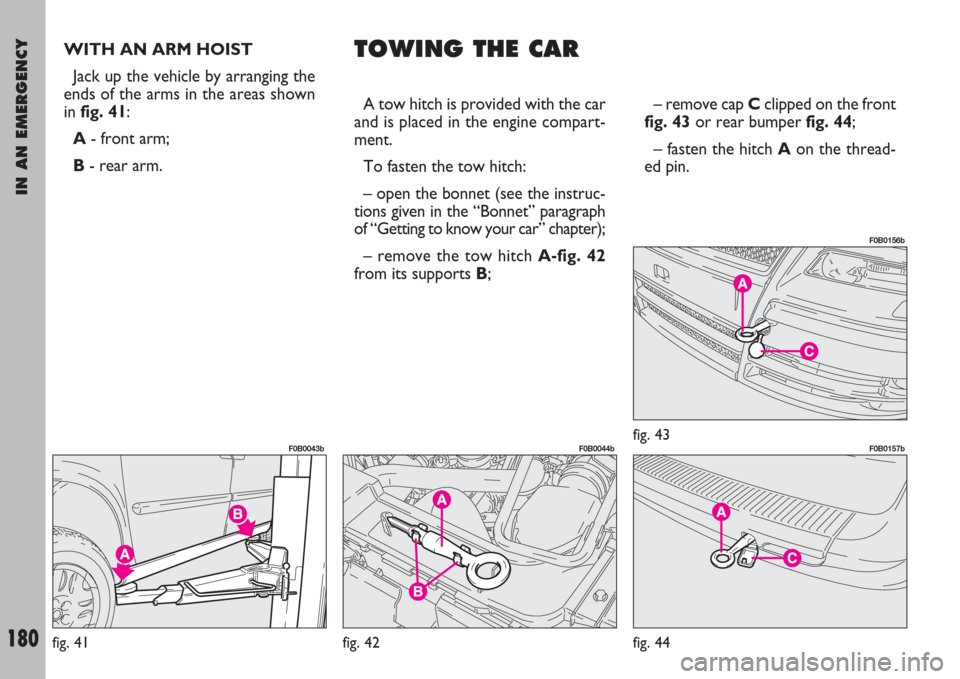
IN AN EMERGENCY
180
WITH AN ARM HOIST
Jack up the vehicle by arranging the
ends of the arms in the areas shown
in fig. 41:
A- front arm;
B- rear arm.TOWING THE CAR
A tow hitch is provided with the car
and is placed in the engine compart-
ment.
To fasten the tow hitch:
– open the bonnet (see the instruc-
tions given in the “Bonnet” paragraph
of “Getting to know your car” chapter);
– remove the tow hitch A-fig. 42
from its supports B;– remove cap Cclipped on the front
fig. 43or rear bumper fig. 44;
– fasten the hitch Aon the thread-
ed pin.
fig. 41
F0B0043b
fig. 42
F0B0044bfig. 43
F0B0156b
fig. 44
F0B0157b
Page 182 of 254
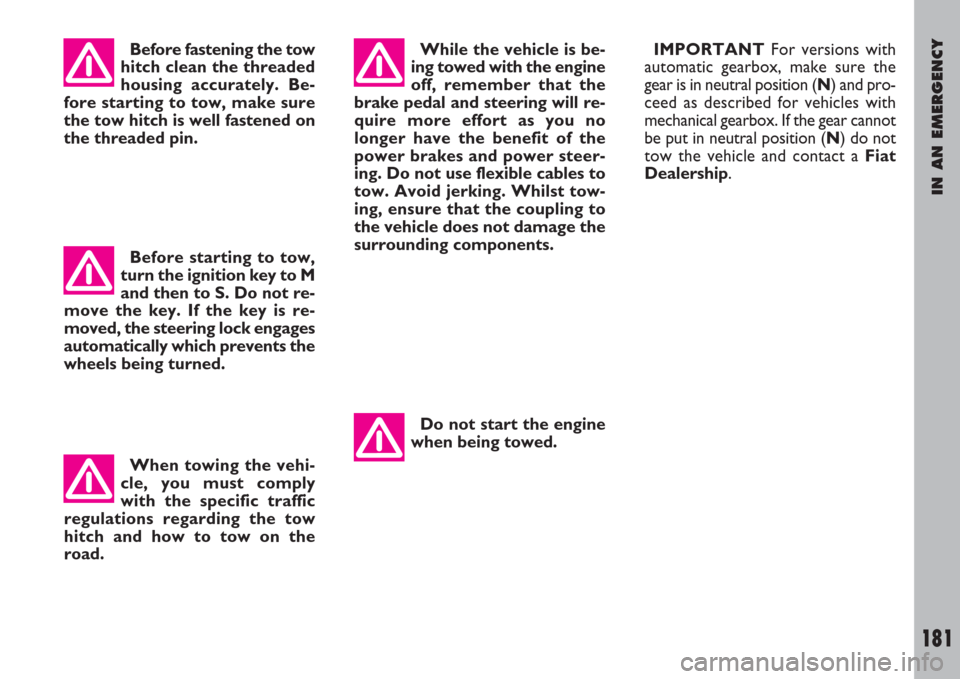
IN AN EMERGENCY
181
Before fastening the tow
hitch clean the threaded
housing accurately. Be-
fore starting to tow, make sure
the tow hitch is well fastened on
the threaded pin.While the vehicle is be-
ing towed with the engine
off, remember that the
brake pedal and steering will re-
quire more effort as you no
longer have the benefit of the
power brakes and power steer-
ing. Do not use flexible cables to
tow. Avoid jerking. Whilst tow-
ing, ensure that the coupling to
the vehicle does not damage the
surrounding components.IMPORTANTFor versions with
automatic gearbox, make sure the
gear is in neutral position (N) and pro-
ceed as described for vehicles with
mechanical gearbox. If the gear cannot
be put in neutral position (N) do not
tow the vehicle and contact a Fiat
Dealership.
Before starting to tow,
turn the ignition key to M
and then to S. Do not re-
move the key. If the key is re-
moved, the steering lock engages
automatically which prevents the
wheels being turned.
When towing the vehi-
cle, you must comply
with the specific traffic
regulations regarding the tow
hitch and how to tow on the
road.
Do not start the engine
when being towed.
Page 183 of 254
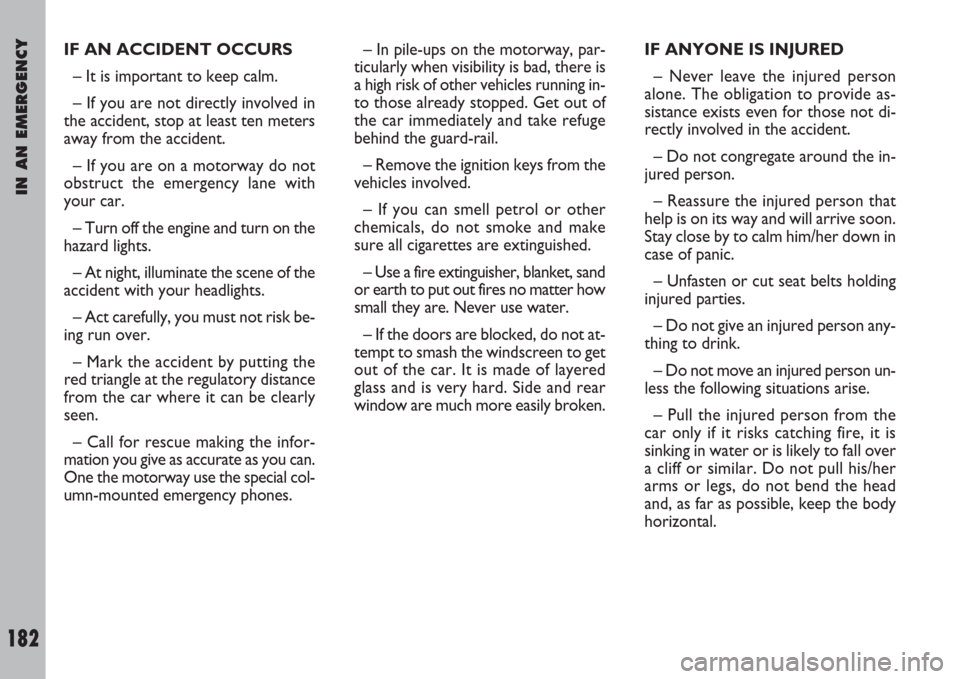
IN AN EMERGENCY
182
IF AN ACCIDENT OCCURS
– It is important to keep calm.
– If you are not directly involved in
the accident, stop at least ten meters
away from the accident.
– If you are on a motorway do not
obstruct the emergency lane with
your car.
– Turn off the engine and turn on the
hazard lights.
– At night, illuminate the scene of the
accident with your headlights.
– Act carefully, you must not risk be-
ing run over.
– Mark the accident by putting the
red triangle at the regulatory distance
from the car where it can be clearly
seen.
– Call for rescue making the infor-
mation you give as accurate as you can.
One the motorway use the special col-
umn-mounted emergency phones.– In pile-ups on the motorway, par-
ticularly when visibility is bad, there is
a high risk of other vehicles running in-
to those already stopped. Get out of
the car immediately and take refuge
behind the guard-rail.
– Remove the ignition keys from the
vehicles involved.
– If you can smell petrol or other
chemicals, do not smoke and make
sure all cigarettes are extinguished.
– Use a fire extinguisher, blanket, sand
or earth to put out fires no matter how
small they are. Never use water.
– If the doors are blocked, do not at-
tempt to smash the windscreen to get
out of the car. It is made of layered
glass and is very hard. Side and rear
window are much more easily broken.IF ANYONE IS INJURED
– Never leave the injured person
alone. The obligation to provide as-
sistance exists even for those not di-
rectly involved in the accident.
– Do not congregate around the in-
jured person.
– Reassure the injured person that
help is on its way and will arrive soon.
Stay close by to calm him/her down in
case of panic.
– Unfasten or cut seat belts holding
injured parties.
– Do not give an injured person any-
thing to drink.
– Do not move an injured person un-
less the following situations arise.
– Pull the injured person from the
car only if it risks catching fire, it is
sinking in water or is likely to fall over
a cliff or similar. Do not pull his/her
arms or legs, do not bend the head
and, as far as possible, keep the body
horizontal.
Page 184 of 254
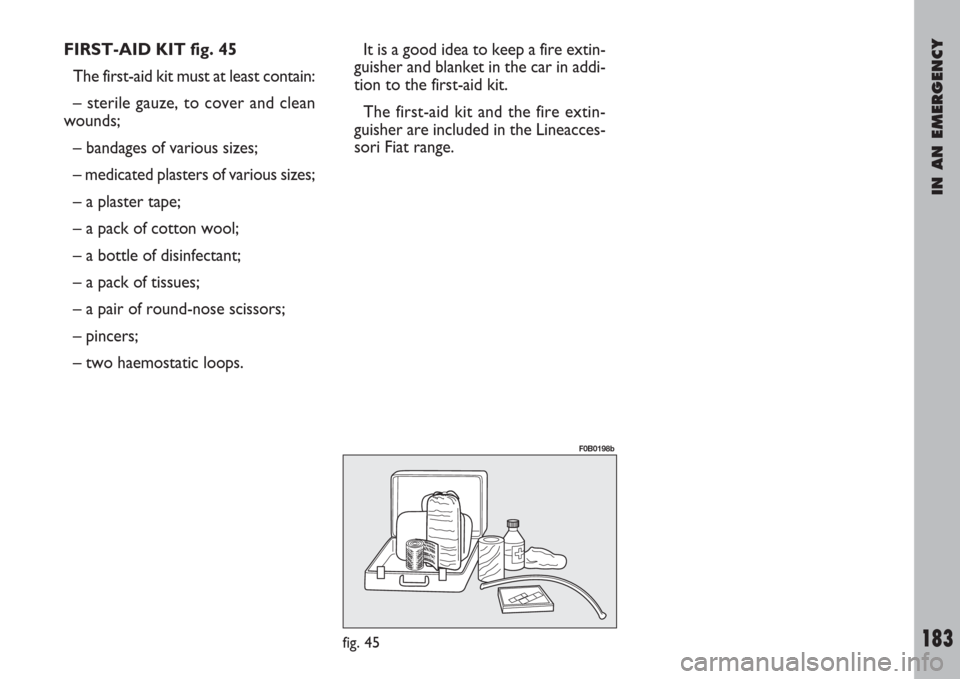
IN AN EMERGENCY
183
FIRST-AID KIT fig. 45
The first-aid kit must at least contain:
– sterile gauze, to cover and clean
wounds;
– bandages of various sizes;
– medicated plasters of various sizes;
– a plaster tape;
– a pack of cotton wool;
– a bottle of disinfectant;
– a pack of tissues;
– a pair of round-nose scissors;
– pincers;
– two haemostatic loops.It is a good idea to keep a fire extin-
guisher and blanket in the car in addi-
tion to the first-aid kit.
The first-aid kit and the fire extin-
guisher are included in the Lineacces-
sori Fiat range.
fig. 45
F0B0198b
Page 185 of 254
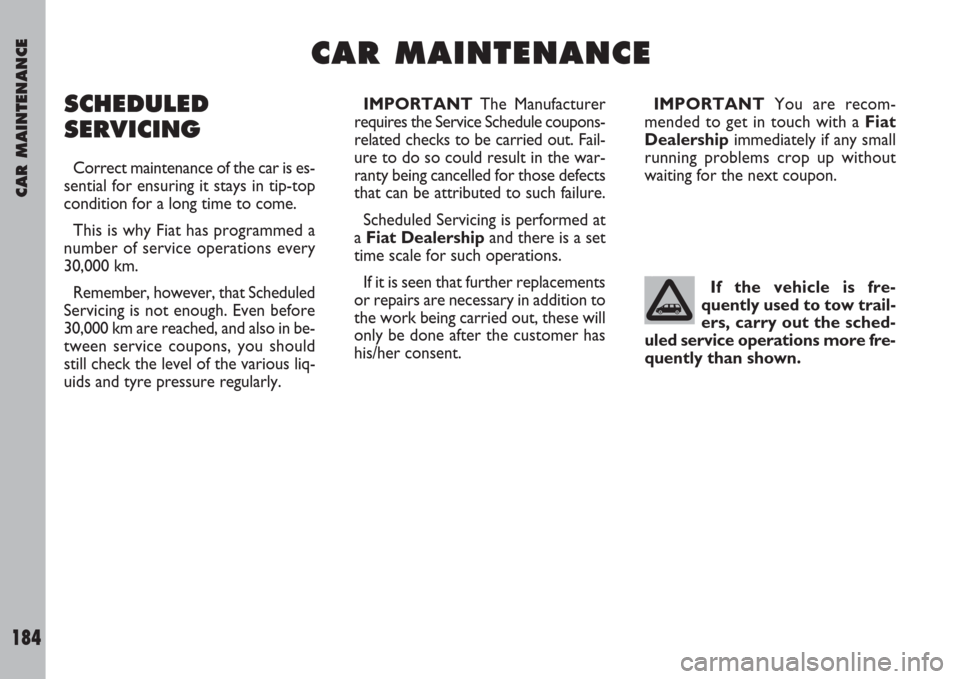
CAR MAINTENANCE
184
C C
A A
R R
M M
A A
I I
N N
T T
E E
N N
A A
N N
C C
E E
SCHEDULED
SERVICING
Correct maintenance of the car is es-
sential for ensuring it stays in tip-top
condition for a long time to come.
This is why Fiat has programmed a
number of service operations every
30,000 km.
Remember, however, that Scheduled
Servicing is not enough. Even before
30,000 km are reached, and also in be-
tween service coupons, you should
still check the level of the various liq-
uids and tyre pressure regularly.IMPORTANTThe Manufacturer
requires the Service Schedule coupons-
related checks to be carried out. Fail-
ure to do so could result in the war-
ranty being cancelled for those defects
that can be attributed to such failure.
Scheduled Servicing is performed at
a Fiat Dealershipand there is a set
time scale for such operations.
If it is seen that further replacements
or repairs are necessary in addition to
the work being carried out, these will
only be done after the customer has
his/her consent.IMPORTANTYou are recom-
mended to get in touch with a Fiat
Dealershipimmediately if any small
running problems crop up without
waiting for the next coupon.
If the vehicle is fre-
quently used to tow trail-
ers, carry out the sched-
uled service operations more fre-
quently than shown.
Page 186 of 254
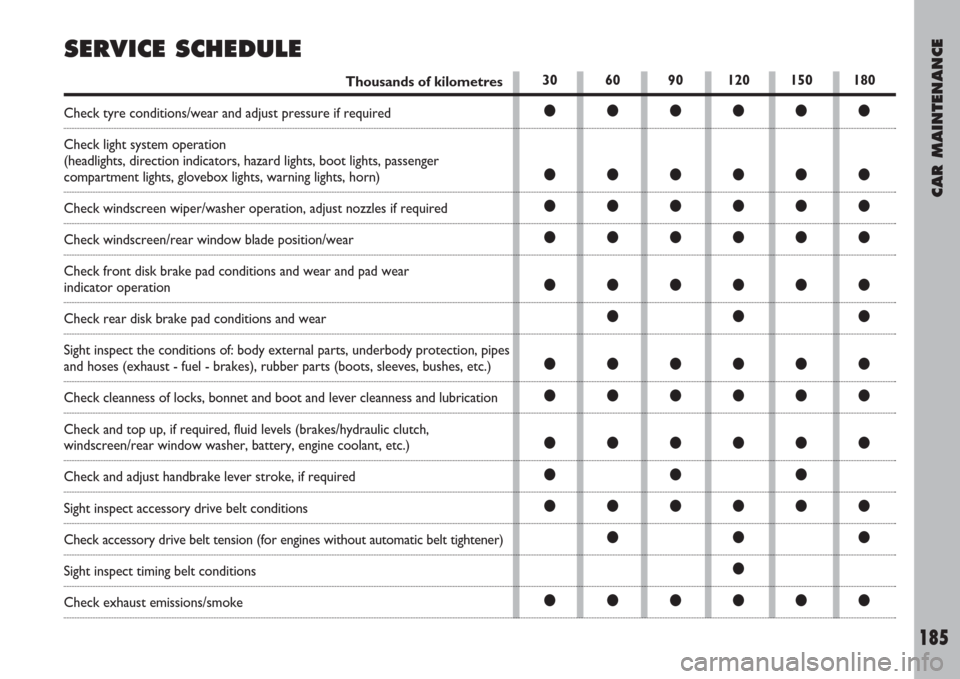
SERVICE SCHEDULE
30 60 90 120 150 180
●●●●●●
●●●●●●
●●●●●●
●●●●●●
●●●●●●
●●●
●●●●●●
●●●●●●
●●●●●●
●●●
●●●●●●
●●●
●
●●●●●●
CAR MAINTENANCE
185
Thousands of kilometres
Check tyre conditions/wear and adjust pressure if required
Check light system operation
(headlights, direction indicators, hazard lights, boot lights, passenger
compartment lights, glovebox lights, warning lights, horn)
Check windscreen wiper/washer operation, adjust nozzles if required
Check windscreen/rear window blade position/wear
Check front disk brake pad conditions and wear and pad wear
indicator operation
Check rear disk brake pad conditions and wear
Sight inspect the conditions of: body external parts, underbody protection, pipes
and hoses (exhaust - fuel - brakes), rubber parts (boots, sleeves, bushes, etc.)
Check cleanness of locks, bonnet and boot and lever cleanness and lubrication
Check and top up, if required, fluid levels (brakes/hydraulic clutch,
windscreen/rear window washer, battery, engine coolant, etc.)
Check and adjust handbrake lever stroke, if required
Sight inspect accessory drive belt conditions
Check accessory drive belt tension (for engines without automatic belt tightener)
Sight inspect timing belt conditions
Check exhaust emissions/smoke
Page 187 of 254
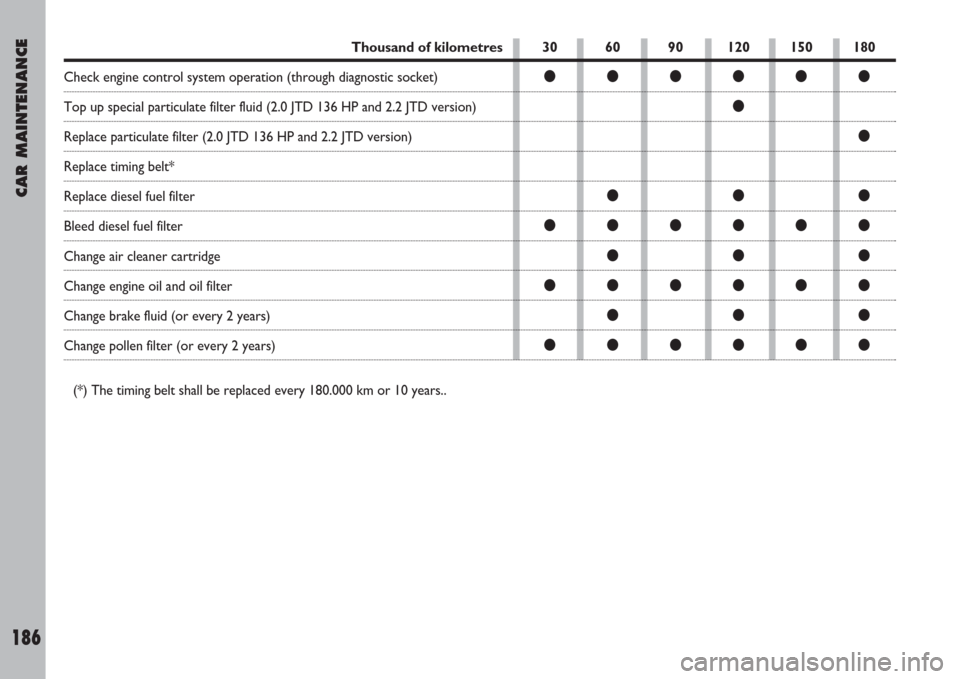
30 60 90 120 150 180
●●●●●●
●
●
●●●
●●●●●●
●●●
●●●●●●
●●●
●●●●●●
CAR MAINTENANCE
186
Thousand of kilometres
Check engine control system operation (through diagnostic socket)
Top up special particulate filter fluid (2.0 JTD 136 HP and 2.2 JTD version)
Replace particulate filter (2.0 JTD 136 HP and 2.2 JTD version)
Replace timing belt*
Replace diesel fuel filter
Bleed diesel fuel filter
Change air cleaner cartridge
Change engine oil and oil filter
Change brake fluid (or every 2 years)
Change pollen filter (or every 2 years)
(*) The timing belt shall be replaced every 180.000 km or 10 years..
Page 188 of 254
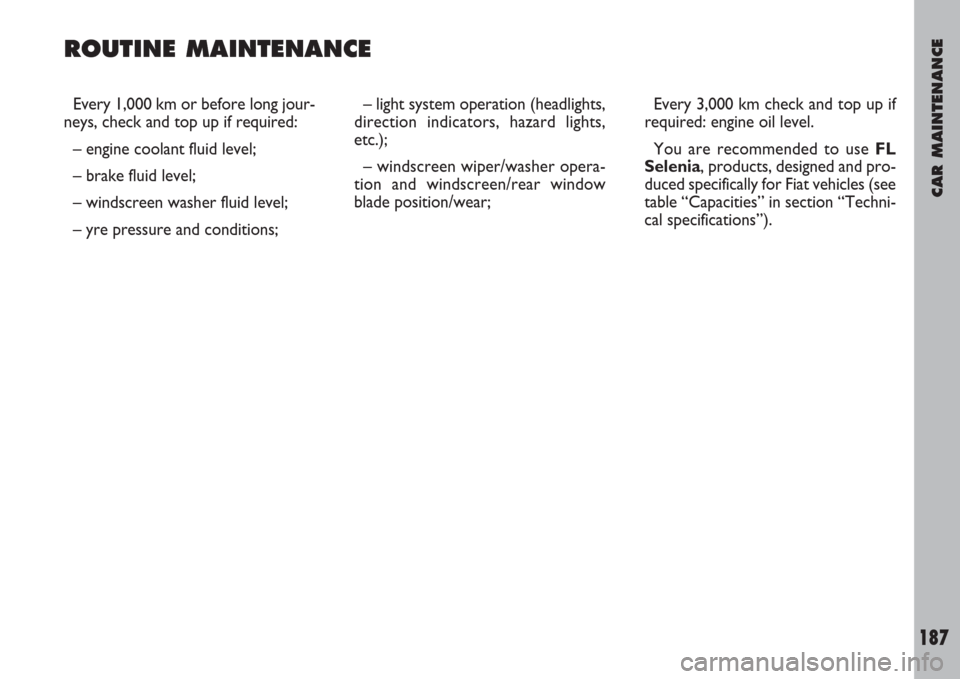
CAR MAINTENANCE
187
Every 1,000 km or before long jour-
neys, check and top up if required:
– engine coolant fluid level;
– brake fluid level;
– windscreen washer fluid level;
– yre pressure and conditions;– light system operation (headlights,
direction indicators, hazard lights,
etc.);
– windscreen wiper/washer opera-
tion and windscreen/rear window
blade position/wear;Every 3,000 km check and top up if
required: engine oil level.
You are recommended to use FL
Selenia, products, designed and pro-
duced specifically for Fiat vehicles (see
table “Capacities” in section “Techni-
cal specifications”).
ROUTINE MAINTENANCE
Page 189 of 254
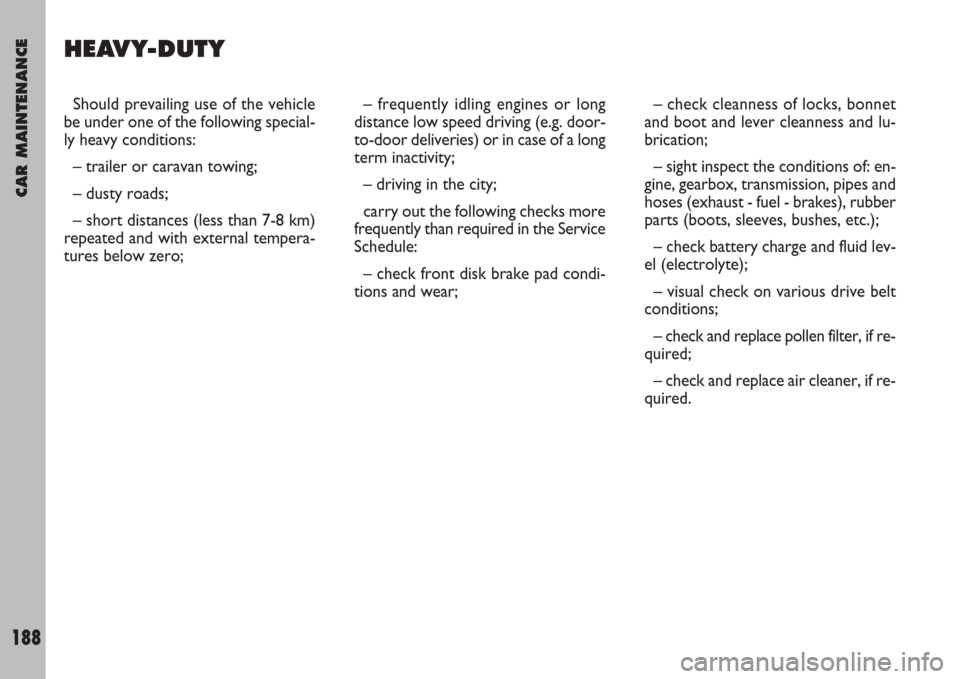
CAR MAINTENANCE
188
Should prevailing use of the vehicle
be under one of the following special-
ly heavy conditions:
– trailer or caravan towing;
– dusty roads;
– short distances (less than 7-8 km)
repeated and with external tempera-
tures below zero;– frequently idling engines or long
distance low speed driving (e.g. door-
to-door deliveries) or in case of a long
term inactivity;
– driving in the city;
carry out the following checks more
frequently than required in the Service
Schedule:
– check front disk brake pad condi-
tions and wear;– check cleanness of locks, bonnet
and boot and lever cleanness and lu-
brication;
– sight inspect the conditions of: en-
gine, gearbox, transmission, pipes and
hoses (exhaust - fuel - brakes), rubber
parts (boots, sleeves, bushes, etc.);
– check battery charge and fluid lev-
el (electrolyte);
– visual check on various drive belt
conditions;
– check and replace pollen filter, if re-
quired;
– check and replace air cleaner, if re-
quired.
HEAVY-DUTY
Page 190 of 254
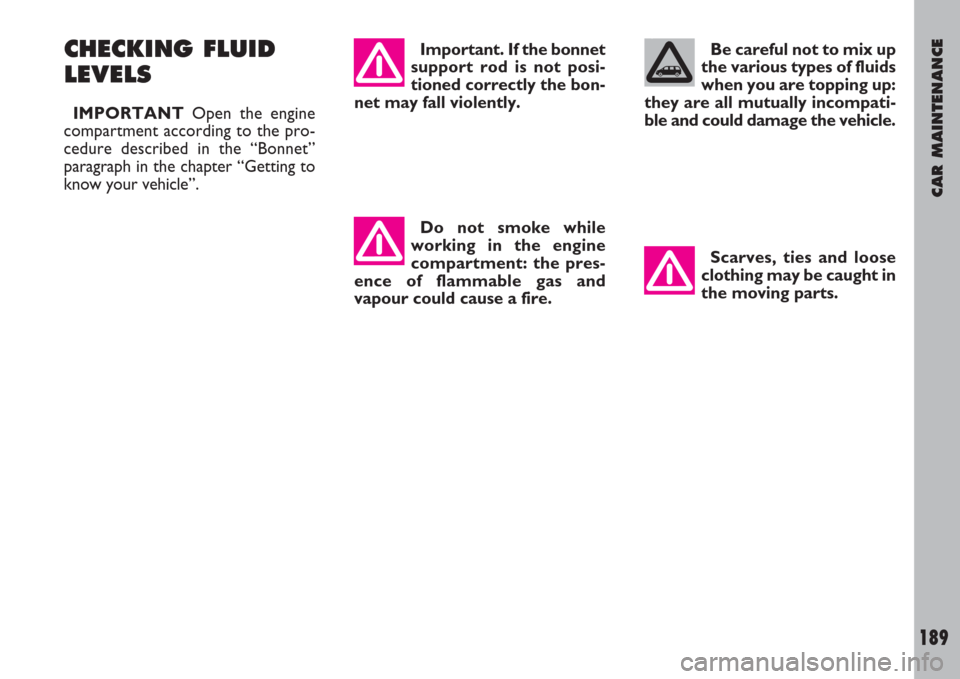
Scarves, ties and loose
clothing may be caught in
the moving parts.Be careful not to mix up
the various types of fluids
when you are topping up:
they are all mutually incompati-
ble and could damage the vehicle.
CAR MAINTENANCE
189
CHECKING FLUID
LEVELS
IMPORTANT Open the engine
compartment according to the pro-
cedure described in the “Bonnet”
paragraph in the chapter “Getting to
know your vehicle”.Important. If the bonnet
support rod is not posi-
tioned correctly the bon-
net may fall violently.
Do not smoke while
working in the engine
compartment: the pres-
ence of flammable gas and
vapour could cause a fire.